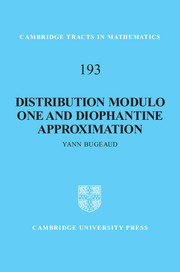Book contents
- Frontmatter
- Contents
- Preface
- Frequently used notation
- 1 Distribution modulo one
- 2 On the fractional parts of powers of real numbers
- 3 On the fractional parts of powers of algebraic numbers
- 4 Normal numbers
- 5 Further explicit constructions of normal and non-normal numbers
- 6 Normality to different bases
- 7 Diophantine approximation and digital properties
- 8 Digital expansion of algebraic numbers
- 9 Continued fraction expansions and β-expansions
- 10 Conjectures and open questions
- Appendix A Combinatorics on words
- Appendix B Some elementary lemmata
- Appendix C Measure theory
- Appendix D Continued fractions
- Appendix E Diophantine approximation
- Appendix F Recurrence sequences
- References
- Index
5 - Further explicit constructions of normal and non-normal numbers
Published online by Cambridge University Press: 05 October 2012
- Frontmatter
- Contents
- Preface
- Frequently used notation
- 1 Distribution modulo one
- 2 On the fractional parts of powers of real numbers
- 3 On the fractional parts of powers of algebraic numbers
- 4 Normal numbers
- 5 Further explicit constructions of normal and non-normal numbers
- 6 Normality to different bases
- 7 Diophantine approximation and digital properties
- 8 Digital expansion of algebraic numbers
- 9 Continued fraction expansions and β-expansions
- 10 Conjectures and open questions
- Appendix A Combinatorics on words
- Appendix B Some elementary lemmata
- Appendix C Measure theory
- Appendix D Continued fractions
- Appendix E Diophantine approximation
- Appendix F Recurrence sequences
- References
- Index
Summary
In Section 4.2, we have constructed explicitly real numbers which are normal to a given base. In the first section of this chapter, we describe another class of explicit real numbers with the same property. Then, we discuss the existence of explicit examples of absolutely normal numbers.
Definition 5.1. A real number is called absolutely normal if it is normal to every integer base b ≥ 2. A real number is called absolutely non-normal if it is normal to no integer base b ≥ 2.
We briefly and partially mention in Section 5.2 the point of view of complexity and calculability theory. Then, in Section 5.3, we give an explicit example of an absolutely non-normal irrational number. We end this chapter with some words on a method proposed by Bailey and Crandall to investigate the random character of arithmetical constants.
Korobov's and Stoneham's normal numbers
In 1946 Good [324] introduced the so-called ‘normal recurring decimals’. Integers b ≥ 2and k ≥ 1 being given, he constructed rational numbers ξ whose b-ary expansion has period bk and is such that every sequence of k digits from {0, 1,…,b − 1} occurs in the b-ary expansion of ξ with the same frequency b−k. An example with b = 2 and k = 3 is given by the rational 23/255 with purely periodic binary expansion of period 00010111. A similar result was independently proved by de Bruijn [143] also in 1946.
Information
- Type
- Chapter
- Information
- Distribution Modulo One and Diophantine Approximation , pp. 102 - 117Publisher: Cambridge University PressPrint publication year: 2012
